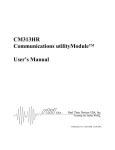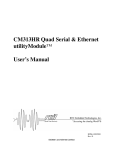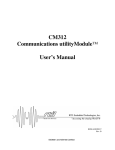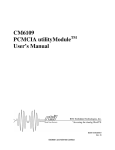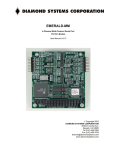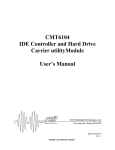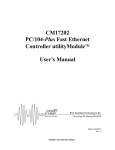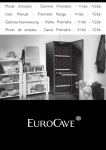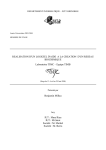Download CM310 Quad Serial Port utilityModule User`s Manual
Transcript
CM310 Quad Serial Port utilityModule User’s Manual BDM-610020016 Rev. B CM310 Quad Serial utilityModule ISO90011 and AS9100 Certified RTD Embedded Technologies, Inc. CM310 Quad Serial Port utilityModule User’s Manual RTD Embedded Technologies, INC. 103 Innovation Blvd. State College, PA 16803-0906 Phone: +1-814-234-8087 FAX: +1-814-234-5218 E-mail [email protected] [email protected] web site http://www.rtd.com CM310 Quad Serial utilityModule 2 RTD Embedded Technologies, Inc. Revision History 08/17/1999 Initial release. 09/14/1999 Pull down resister jumpers added 10/18/1999 Self-explanatory diagnostic program included 10/29/1999 Include 24Mhz clock to support 1.5 Mbps transceiver operation 02/01/2000 Changed SW2 to 8 position and made SW3 and SW4 terminations 02/02/2000 Reversed RS-422 signal names polarity (+/-) 02/08/2000 Removed 25 pin D connector for RS-422 mode Rev. A New Manual Naming Method Rev. B (02/20/2008) - Corrected default IRQ jumper settings to match current shipping configuration. - Resolved some ambiguity in the COM port numbering - Added a note about IRQ sharing and OS limitations Published by: RTD Embedded Technologies, Inc. 103 Innovation Blvd. State College, PA 16803-0906 Copyright 1999, 2002, 2003, 2008 by RTD Embedded Technologies, Inc. All rights reserved The RTD Logo is a registered trademark of RTD Embedded Technologies. cpuModule and utilityModule are trademarks of RTD Embedded Technologies. PhoenixPICO and PheonixPICO BIOS are trademarks of Phoenix Technologies Ltd. PS/2, PC/XT, PC/AT and IBM are trademarks of International Business Machines Inc. MSDOS, Windows, Windows 95, Windows 98 and Windows NT are trademarks of Microsoft Corp. PC/104 is a registered trademark of PC/104 Consortium. All other trademarks appearing in this document are the property of their respective owners. CM310 Quad Serial utilityModule 3 RTD Embedded Technologies, Inc. Table of Contents CHAPTER 1 INTRODUCTION............................................................................................................................6 CM310 QUAD SERIAL PORT UTILITYMODULE ...........................................................................................................6 CONFIGURING THE UTILITYMODULE ...........................................................................................................................7 CHAPTER 2 INSTALLING THE UTILITYMODULE....................................................................................13 RECOMMENDED PROCEDURE ...................................................................................................................................13 FINDING PIN 1 OF CONNECTORS ...............................................................................................................................13 PC/104 BUS CONNECTORS, CN1 AND CN2..............................................................................................................15 FIRST COM PORT, CN3 ............................................................................................................................................16 RS232 SERIAL PORT (DEFAULT) ..............................................................................................................................17 RS422 OR RS485 SERIAL PORT ................................................................................................................................18 SECOND COM PORT, CN4........................................................................................................................................19 THIRD COM PORT, CN5...........................................................................................................................................19 FOURTH COM PORT, CN6 ........................................................................................................................................19 CM310 COMMON REGISTERS ....................................................................................................................................20 CHAPTER 3 USING THE UTILITYMODULE................................................................................................22 COM PORTS .............................................................................................................................................................22 1.5 MBPS SUPPORT ...................................................................................................................................................22 INTERRUPT SHARING ................................................................................................................................................22 DIAGNOSTIC SOFTWARE ...........................................................................................................................................23 POWER PROTECTION CIRCUITRY ..............................................................................................................................24 CHAPTER 4 RETURN POLICY AND WARRANTY......................................................................................25 RETURN POLICY .......................................................................................................................................................25 LIMITED WARRANTY ................................................................................................................................................26 CM310 Quad Serial utilityModule 4 RTD Embedded Technologies, Inc. Table of Tables TABLE 1 DEFAULT JUMPER SETTINGS ............................................................................................................................9 TABLE 2 SWITCH AND JUMPER TABLES.........................................................................................................................10 TABLE 3 BASE ADDRESS TABLE FOR COM PORTS ........................................................................................................12 TABLE 4 CONNECTOR TABLE .......................................................................................................................................14 TABLE 5 PC/104 XT BUS CONNECTOR......................................................................................................................15 TABLE 6 PC/104 AT BUS CONNECTOR ........................................................................................................................16 TABLE 7 CONNECTOR CN3 IN RS-232 MODE (I)..........................................................................................................17 TABLE 8 CONNECTOR CN3 IN RS-232 MODE (II).........................................................................................................17 TABLE 9 CONNECTOR CN3 IN RS422/485 MODE (I) ....................................................................................................18 TABLE 10 CONNECTOR CN3 IN RS422/485 MODE (II).................................................................................................18 Table of Figures FIGURE 1 SWITCH & JUMPER LOCATIONS .......................................................................................................................8 FIGURE 2 CONNECTOR LOCATIONS...............................................................................................................................14 CM310 Quad Serial utilityModule 5 RTD Embedded Technologies, Inc. Chapter 1 INTRODUCTION This manual gives information on the CM310 Quad Serial Port utilityModule. This module supports four versatile serial ports for the 16 (Intel) bus interface type, with jumper configurable IRQ lines and I/O addresses for your PC/104 applications. CM310 Quad Serial Port utilityModule The CM310 Quad Serial Port utilityModule was designed to provide four versatile serial ports to support the Real Time Devices cpuModules and other standard PC/104 processor modules. Features The following are major features of the CM310 utilityModule. • Compatibility with the Industry Standard 16C550 • 1.5 Mbps baud transmit/receive operation (24Mhz) • 16 byte transmit FIFO/16 byte receive FIFO with error flags • Independent transmit and receive control • Standard modem interface • Jumper selectable interrupt line, base address, RS232/RS422-485 mode per port • Jumper selectable enable/disable per port • Includes 42 different selectable I/O base addresses • Extended temperature range: -40 to +85C • Low power-consumption • Typical from single +5V power supply Software Included • Self-explanatory diagnostic program included CM310 Quad Serial utilityModule 6 RTD Embedded Technologies, Inc. Connectors and Switches Connectors provided are: • CN1: PC/104 Bus (XT) • CN2: PC/104 Bus (AT) • CN3: First COM port • CN4: Second COM port • CN5: Third COM port • CN6: Fourth COM port Switches provided are: • • • • SW1: Base address selection SW2: Enable/Disable and RS232/RS422-486 mode SW3: First and second port RS422/485 termination SW4: Third and forth port RS422/485 termination Recommended Cables XK-CM310 General Specifications • • • • • • • Dimensions: 3.8 x 3.9 x 0.6" (97 x 100 x 16 mm) Weight (mass): 3.0 ounces (85 grams) 6-layer PCB Operating conditions: Temperature: -40 - +85 degrees C Relative humidity: 0 - 95%, non-condensing Storage temperature: -55 to +125 degrees C Configuring the utilityModule The following sections contain information on configuring the utilityModule. Please read this entire section before attempting to use the utilityModule! CM310 Quad Serial utilityModule 7 RTD Embedded Technologies, Inc. Jumpers and Switches Locations The figure below shows switch and jumper locations. Figure 1 Switch & Jumper Locations CM310 Quad Serial utilityModule 8 RTD Embedded Technologies, Inc. Default Settings The utilityModule is delivered from the factory configured according to the following table. Table 1 Default Jumper Settings Jumper JP1 G jumper JP2 G jumper JP3 G jumper JP4 G jumper JP5 CLK jumper SW1 Setting Not Installed Installed Not Installed Installed Not Installed Installed Not Installed Installed 2-3 installed Function Interrupts Disabled for 1st COM port 1K pull down resister on IRQ4 line Interrupts Disabled for 2nd COM port 1K pull down resister on IRQ3 line Interrupts Disabled for 3rd COM port 1K pull down resister on IRQ5 line Interrupts Disabled for 4th COM port 1K pull down resister on IRQ10 line 1.8432 MHz input clock is selected All down SW2 1-4 up 5-8 down All up All up I/O base addresses at 3E8, 2E8, 280, 288 for 1st, 2nd,3rd and 4th COM port respectively All COM ports enabled All ports in RS232 mode No serial termination resistors No serial termination resistors SW3 SW4 CM310 Quad Serial utilityModule 9 RTD Embedded Technologies, Inc. Descriptions The following table describes the functions of the jumpers. Table 2 Switch and Jumper tables Jumper JP 1 Use IRQ selection for 1st COM Port (CN3) G setting: jumper installed = 1K pull down resistor for the selected IRQ Jumper removed = no pull down for the selected IRQ JP 2 IRQ selection for 2nd COM Port (CN4) G setting: jumper installed = 1K pull down resistor for the selected IRQ Jumper removed = no pull down for the selected IRQ JP3 IRQ selection for 3rd COM Port (CN5) G setting: jumper installed = 1K pull down resistor for the selected IRQ Jumper removed = no pull down for the selected IRQ JP 4 IRQ selection for 4th COM Port (CN6) G setting: jumper installed = 1K pull down resistor for the selected IRQ Jumper removed = no pull down for the selected IRQ JP5 Input clock selection for serial ports 1-2 = select 24 MHz input clock to UART 2-3 = select 1.8432 MHz input clock to UART SW1 SW2 Positions 1-4 I/O base address switch. See Base Address Table for details Up = enable serial port Down = disable serial port Switch position Port 1 CN3 2 CN4 3 CN5 4 CN6 SW2 Positions 5-8 Up = RS422/485 mode Down = RS232 mode Switch position Port 5 CN3 6 CN4 7 CN5 8 CN6 SW3 Up = Don't use on-board serial termination resistor Down = Use 120 on-board serial termination resistor for RS422/485 mode Switch position Port and signal 1 CN3 -- RxD 2 CN3 -- CTS 3 CN4 -- RxD 4 CN4 -- CTS CM310 Quad Serial utilityModule 10 RTD Embedded Technologies, Inc. SW4 Up = Don't use on-board serial termination resistor Down = Use 120 on-board serial termination resistor for RS422/485 mode Switch position Port and signal 1 CN5 -- RxD 2 CN5 -- CTS 3 CN6 -- RxD 4 CN6 -- CTS CM310 Quad Serial utilityModule 11 RTD Embedded Technologies, Inc. Table 3 Base address table for COM ports COM port addresses –base address in Hex for eight 8-bit registers SW1-4 SW-3 SW-2 SW-1 CN3 CN4 CN5 CN6 Down Down Down Down 3E8 2E8 280 288 Down Down Down Up 280 288 290 298 Down Down Up Down 290 298 2A0 2A8 Down Down Up Up 2A0 2A8 2B0 2B8 Down Up Down Down 100 108 110 118 Down Up Down Up 120 128 130 138 Down Up Up Down 140 148 150 158 Down Up Up Up 160 168 170 178 Up Down Down Down 100 108 500 508 Up Down Down Up 120 128 520 528 Up Down Up Down 280 288 680 688 Up Down Up Up 290 298 690 698 Up Up Down Down 2A0 2A8 6A0 6A8 Up Up Down Up 2B0 2B8 6B0 6B8 Up Up Up Down 3E8 2E8 7E8 6E8 Up Up Up Up 3F8 2F8 3E8 2E8 CM310 Quad Serial utilityModule 12 RTD Embedded Technologies, Inc. Chapter 2 INSTALLING THE UTILITYMODULE Since the utilityModule uses a PC/104 stackthrough bus, the only hardware installation you will do is placing the module to the PC/104 stack. To do this, you will connect the PC/104 bus connector with the matching connector of another module. Recommended Procedure We recommend you follow the procedure below to ensure that stacking of the modules does not damage connectors or electronics. • Turn off power to the PC/104 system or stack. • Select and install standoffs to properly position the utilityModule on the PC/104 stack. • Touch a grounded metal part of the stack to discharge any buildup of static electricity. • Remove the utilityModule from its anti-static bag. • Check that keying pins in the PC/104 bus connector are properly positioned. • Check the stacking order: make sure an XT bus card will not be placed between two AT bus cards, or it will interrupt the AT bus signals. • Hold the utilityModule by its edges and orient it so the bus connector pins line up with the matching connector on the stack. • Gently and evenly press the utilityModule onto the PC/104 stack. CAUTION: Do not force the module onto the stack! Wiggling the module or applying too much force may damage it. If the module does not readily press into place, remove it, check for bent pins or out-of-place keying pins, and try again. Connecting the utilityModule The following sections describe connectors of the utilityModule. Finding Pin 1 of Connectors A white area silk-screened on the PC board indicates pin 1 of connectors. A square solder pad visible on the bottom of the PC board also indicates it. CM310 Quad Serial utilityModule 13 RTD Embedded Technologies, Inc. Locations The figure below shows connector locations. Figure 2 Connector Locations Table 4 Connector Table Connector CN1 CN2 CN3 CN4 CN5 CN6 CM310 Quad Serial utilityModule Function PC/104 XT Bus PC/104 AT Bus 1st COM port 2nd COM port 3rd COM port 4th COM port 14 Size 64 pin 40 pin 10 pin 10 pin 10 pin 10 pin RTD Embedded Technologies, Inc. PC/104 Bus Connectors, CN1 and CN2 Connectors CN1 and CN2 provide PC/104 bus connections. CN1 carries XT bus signals, and CN2 carries additional signals for the AT bus. The signals on CN1 and CN2 conform to the IEEE P966 standard for the PC/104 bus. The following tables list the connector pinouts: Table 5 PC/104 XT Bus Connector Pin 1 2 3 4 5 6 7 8 9 10 11 12 13 14 15 16 17 18 19 20 21 22 23 24 25 26 27 28 29 30 31 32 CM310 Quad Serial utilityModule PC/104 XT Bus Connector, CN1 Row A Row B IOCHCHK* SD7 SD6 SD5 SD4 SD3 SD2 SD1 SD0 IOCHRDY AEN SA19 SA18 SA17 SA16 SA15 SA14 SA13 SA12 SA11 SA10 SA9 SA8 SA7 SA6 SA5 SA4 SA3 SA2 SA1 SA0 0V 15 0V RESETDRV +5V IRQ9 -5V DRQ2 -12V ENDXFR* +12V (KEYING PIN) SMEMW* SMEMR* IOW* IOR* DACK3 DRQ3 DACK1* DRQ1 REFRESH SYSCLK IRQ7 IRQ6 IRQ5 IRQ4 IRQ3 DACK2* TC BALE +5V OSC 0V 0V RTD Embedded Technologies, Inc. Table 6 PC/104 AT Bus Connector Pin 0 1 2 3 4 5 6 7 8 9 10 11 12 13 14 15 16 17 18 19 Note: PC/104 AT Bus Connector, CN2 Row C Row D 0V SBHE* LA23 LA22 LA21 LA20 LA19 LA18 LA17 MEMR* MEMW* SD8 SD9 SD10 SD11 SD12 SD13 SD14 SD15 (KEYING PIN) 0V MEMCS16* IOCS16* IRQ10 IRQ11 IRQ12 IRQ15 IRQ14 DACK0* DRQ0 DACK5* DRQ5 DACK6* DRQ6 DRQ6 DRQ7 +5V MASTER* 0V 0V Two locations on the bus have mechanical keying pins to help prevent misconnection of the PC/104 bus. These keying pins are a part of the PC/104 standard, and we strongly recommend you leave them in place. If you have other modules without keying pins, we suggest you modify them to include keying. First COM port, CN3 The first serial port is implemented on connector CN3. It can be configured as a PC compatible full duplex RS232 port or as half- or full duplex RS422 or RS485 through mode SW3. The I/O address is configurable in respect to SW1 address table, and corresponding interrupt is also selectable through jumper JP1 to be IRQ3, IRQ4, IRQ5, IR6, IRQ7, IRQ9, IRQ10, IRQ11, IRQ12, IRQ14 and IRQ15. But you need to make sure that there are no resource conflicts on the I/O base address and interrupt line you choose. The serial port is implemented with a 16C550-compatible UART (Universal Asynchronous Receiver/Transmitter). This UART is capable of baud rates up to 115.2K. CM310 Quad Serial utilityModule 16 RTD Embedded Technologies, Inc. RS232 Serial Port (Default) The full-duplex RS232 mode is the default setting on the utilityModule. With this mode enabled, connector CN3 must be connected to RS232 compatible devices. The following table gives the connector pinout and shows how to connect to an external serial connector, either DB25 or DB9 compatible. Connector CN3 in RS-232 Mode Table 7 Connector CN3 in RS-232 Mode (I) CN3 Pin Signal Function In/out DB25 DB9 1 DCD Data Carrier Detect In 8 1 2 DSR Data Set Ready In 6 6 3 RXD Receive Data In 3 2 4 RTS Request To Send Out 4 7 5 TXD Transmit Data Out 2 3 6 CTS Clear To Send In 5 8 7 DTR Data Terminal Ready Out 20 4 8 RI Ring Indicate In 22 9 9,10 GND Signal Ground -- 7 5 Facing the connector pins, the pinout is pictured in the following, Table 8 Connector CN3 in RS-232 Mode (II) 9 7 5 3 1 GND DTR TXD RXD DCD GND RI CTS RTS DSR 10 8 6 4 2 CM310 Quad Serial utilityModule 17 RTD Embedded Technologies, Inc. RS422 or RS485 Serial Port You can change the mode switch to set the first port as RS422 or RS485. In this case, you must connect CN3 to an RS422 or RS485 compatible device. When using RS422 or RS485 mode, you can use the port in either half-duplex (two-wire) or fullduplex (four-wire) configurations. For half-duplex (2-wire) operation, you must connect RXD+ to TDX+, and connect RXD- to TXD-. Note! A 120-ohm termination resistor is provided on the utilityModule. Termination is usually necessary on all RS422 receivers and at the ends of the RS485 bus. If the termination resistor is required, it can be enabled by closing corresponding bits on SW3 or SW4. RS422 and RS485 Mode Pinout The following table gives the pinout of connector CN3 when RS422 or RS485 modes are enabled. Table 9 Connector CN3 in RS422/485 Mode (I) CN3 Pin Signal Function In/out DB9 1 RTS- Request to send (-) Out 1 2 RTS+ Request to send (+) Out 6 3 RXD- Receive Data (-) In 2 4 TXD+ Transmit Data (+) Out 7 5 TXD- Transmit Data(-) Out 3 6 RXD+ Receive Data (+) In 8 7 CTS- Clear to send (-) In 4 8 CTS+ Clear to send (+) In 9 9,10 GND Signal Ground -- 5 Facing the connector pins, the pinout is pictured in the following, Table 10 Connector CN3 in RS422/485 Mode (II) 9 7 5 3 1 GND CTS- TXD- RXD- RTS- GND CTS+ RXD+ TXD+ RTS+ 10 8 6 4 2 CM310 Quad Serial utilityModule 18 RTD Embedded Technologies, Inc. Notes on using RS422 or RS485 Modes When using the serial port in RS422 or RS485 mode, the serial receiver is always enabled, however the serial transmitter is enabled and disabled under software control in the following two ways. By default, the transmitter is enabled by manipulating the Request To Send (RTS*) signal of the serial port controller. This signal is controlled by writing bit 1 of the Modem Control Register (MCR) as follows: • • If MCR bit 1 = 1, then RTS* = 0, and serial transmitter is disabled If MCR bit 1 = 0, then RTS* = 1, and serial transmitter is enabled For more information on the serial port registers, including the MCR, please refer to a standard PC-AT hardware reference for the 16C550 UART, or refer to RTDUSA application note ANC102 at http://www.rtdusa.com The other way to enable the serial transmitter is to write 1 to its corresponding bit of the utilityModule’s internal common register 4, which sets the serial transmitter in “always on” mode. Please refer to Internal Common Register Section for detail. Second COM port, CN4 Please refer to the previous section on the first COM port CN3 for the description on CN4. Third COM port, CN5 Please refer to the previous section on the first COM port CN3 for the description on CN5. Fourth COM port, CN6 Please refer to the previous section on the first COM port CN3 for the description on CN6. CM310 Quad Serial utilityModule 19 RTD Embedded Technologies, Inc. CM310 common registers The utilityModule includes 5 common registers to provide additional information and software control that is not required for normal COM port operation, but may be helpful in determining the status of the board and configuring of the board. The following two sections give the location and definition of the common registers. Base Address of Common Registers The utilityModule common registers are located 800h above the address of the first enabled COM port. That is, assuming that “X” in hex is the first enabled COM port base address, which can be any of the valid addresses listed in the Com Port Address Table, the base address for the common registers is “Y” in hex, then, Y = X + 800h For example, if the switches of SW4 are set all DOWN position which makes CN3 = 3E8h, CN4 = 2E8h, CN5 = 280h and CN6 = 288h, then according to the algorithm, the common registers base address (BA) will be the following depending the setting of enable switch SW2 for each serial port, If CN3 is enabled then, BA = 3E8h + 800h = BE8h Else if CN3 is disabled AND CN4 is enabled then, BA = 2E8h + 800h = AE8h Else if CN3 and CN4 are disabled AND CN5 is enabled then, BA = 280h + 800h = A80h Else if CN3, CN4 and CN5 are disabled AND CN4 is enabled then, BA = 288h + 800h = A88 A80h Else if CN3, CN4, CN5 and CN6 are disabled then, Common Registers are disabled End If CM310 Quad Serial utilityModule 20 RTD Embedded Technologies, Inc. Common Register definitions BA + 0 – Interrupt Status (Read Only) 7 6 5 4 3 2 Reserved Reserved TxRDY* RxRDY* CN6 CN5 For each CNx bit: 0 = Not interrupting 1 = Interrupt set TxRDY* 0 = indicates a buffer ready for at least one of the four transmit channels 1 = indicates that all transmit buffers are full RxRDY* 0 = indicates one or more of the receive channels has data ready to read 1 = indicates that all receive buffers are empty Reserved reads as 0 BA + 1 – Address Switch (Read Only) 7 6 5 4 3 2 Reserved Reserved Reserved Reserved SW1-4 SW1-3 For each bit, see table above 0 = Down 1 = Up Reserved reads as A to tag on the address register. BA + 2 -- Enable/Disable Switch (Read Only) 7 6 5 4 3 2 Reserved Reserved Reserved Reserved CN6 CN5 For each CNx bit: 0 = Port is disabled 1 = Port is enabled Reserved reads as 0xA for clarity 7 6 Reserved Reserved For each CNx bit: If 0 = RS-232 1 = RS-422/485 Reserved reads as 0 BA + 3—Mode Switch (Read Only) 5 4 3 2 Reserved Reserved CN6 CN5 BA + 4-- RS-422 RTS operation (R/W) 7 6 5 4 3 2 Reserved Reserved Reserved IntSel CN6 CN5 IntSel: 0 = MCR bit-3 controls the three state interrupt output. 1 = Overrides MCR bit-3 and interrupt outputs are enabled continuously. Default to 0 to set COM ports in normal mode For each CNx bit: If Mode = RS-232 then Not used, Reads as 0 Else If Mode = RS-422/485 then 0 = use RTS to enable transmitter, default case 1 = transmitter always on CM310 Quad Serial utilityModule 21 1 CN4 0 CN3 1 SW1-2 0 SW1-1 1 CN4 0 CN3 1 CN4 0 CN3 1 CN4 0 CN3 RTD Embedded Technologies, Inc. Chapter 3 USING THE UTILITYMODULE COM ports The utilityModule features EXAR quad UART 16C550 compatible 16C554D part. EXAR Documentation Due to the complexity of the EXAR serial chip, it is impossible for us to reproduce all programming information in this manual. If you will be doing in-depth programming of the serial port controller, we suggest you obtain the 16C554D datasheet from the manufacturer. The 16C554D datasheet is available on-line in electronic format as an Adobe Acrobat (. PDF) file on the EXAR website: www.exar.com You may also contact: EXAR Corporation 248720 Kato Road Fremont, CA 94538 1.5 Mbps support With 24 MHz clock input selected (JP5, 1-2), the utilityModule is capable of provide data rates up to 1.5 Mbps in RS422/RS485 mode. Since RS232 standard restricts data rate to 20 Kbps, you might experience failure at higher data rate above 252 Kbps with 24 MHz clock select for the utilityModule. Interrupt Sharing Interrupt sharing is a mechanism which allows different devices sharing same active high IRQ lines on the PC/104 bus, given that there is a interrupt sharing circuit associated with each device. The utilityModule provides interrupt-sharing circuits for all the serial ports; thus it allows sharing of one IRQ line among the serial ports in the utilityModule. However, user needs to be careful to share an IRQ line with devices in the system elsewhere, and be sure that other devices also share their IRQ lines as well. For instance, users should be aware of that the IRQ3/IRQ4 associated with serial port J3/J4 on RTDUSA cpuModule are not shareable. And if the utilityModule is in the same system with RTDUSA cpuModule, be advised not to use/share IRQ3/IRQ4 for the utilityModule unless you have serial ports on the cpuModule disabled. Interrupt sharing in a PC/104 system requires one 1K pull-down resistor per IRQ line for all the devices that share the IRQ. Installing a G jumper in the utilityModule will pull its associated IRQ line down with 1K resistor. That is, for example, if IRQn is shared among four serial ports on the utilityModule, only one G jumper needs to be installed for IRQn line. If more than one G jumper are installed, the pull-down on IRQn line will be much stronger that expected 1K ohm, which will prevent interrupt controller from functioning correctly. CM310 Quad Serial utilityModule 22 RTD Embedded Technologies, Inc. NOTE: Some operating systems do not support IRQ sharing for ISA devices. If the OS does not support ISA IRQ sharing, then you must assign each com port to its own IRQ. Let consider two cases to demonstrate the concepts for the above discussion. Let us assume that IRQ5 and IRQ10 are not used and driven by other devices in the system. For the first case, IRQ10 line is shared among the four serial ports and for the second case IRQ5 is shared for port 1 and port 2, while IRQ10 is shared among port 3 and port 4. The following two tables listed the interrupt jumper settings for each case respectively. Table 11 Jumper Settings for interrupt sharing Case 1 Jumper JP1 G jumper Setting 13-14 Installed JP2 G jumper 13-14 Removed JP3 G jumper 13-14 Removed JP4 G jumper 13-14 Removed Function IRQ10 for 1st COM port 1K pull down resister added on IRQ10 from PORT1 IRQ10 for 2nd COM port No pull down resister added on IRQ10 from PORT2 IRQ10 for 3rd COM port No pull down resister added on IRQ10 from PORT3 IRQ10 for 4th COM port No pull down resister added on IRQ10 from PORT4 Table 12 Jumper Settings for interrupt sharing Case 2 Jumper JP1 G jumper Setting 5-6 Installed JP2 G jumper 5-6 Removed JP3 G jumper 13-14 Installed JP4 G jumper 13-14 Removed Function IRQ5 for 1st COM port 1K pull down resister added on IRQ5 from PORT1 IRQ5 for 2nd COM port No pull down resister added on IRQ5 from PORT2 IRQ10 for 3rd COM port 1K pull down resister added on IRQ10 from PORT3 IRQ10 for 4th COM port No pull down resister added on IRQ10 from PORT4 Diagnostic Software The companion CD for the utilityModule includes a menu driven diagnostic program. Loop back plugs are required to run this program. CM310 Quad Serial utilityModule 23 RTD Embedded Technologies, Inc. Power Protection Circuitry To reduce the risk of damage due to power-supply problems, the utilityModule includes several protective components. Module Power-Supply Protection The utilityModule includes a component to help prevent damage due to problems with the +5Vdc power supply from the PC/104 bus. Protection is provided for: • Over-current • Reversed polarity • Excessive voltage This protection is only for the utilityModule, and will not protect other devices in a PC/104 stack. The protective fuse is replaceable and is available from electronics suppliers. Its description and part number is: Littelfuse Nano2 SMF 1.0 amp, R451-001 Caution: Replace fuses only with parts of identical current and voltage rating. CM310 Quad Serial utilityModule 24 RTD Embedded Technologies, Inc. Chapter 4 RETURN POLICY AND WARRANTY Return Policy If you wish to return a product to the factory for service, please follow this procedure: Read the Limited Warranty to familiarize yourself with our warranty policy. Contact the factory for a Return Merchandise Authorization (RMA) number. Please have the following available: • • • Complete board name Board serial number A detailed description of the board’s behavior List the name of a contact person, familiar with technical details of the problem or situation, along with their phone and fax numbers, address, and e-mail address (if available). List your shipping address!! Indicate the shipping method you would like used to return the product to you. We will not ship by next-day service without your pre-approval. Carefully package the product, using proper anti-static packaging. Write the RMA number in large (1") letters on the outside of the package. Return the package to: RTD Embedded Technologies, Inc. 103 Innovation Blvd. State College PA 16803-0906 USA CM310 Quad Serial utilityModule 25 RTD Embedded Technologies, Inc. Limited Warranty RTD Embedded Technologies, Inc. warrants the hardware and software products it manufactures and produces to be free from defects in materials and workmanship for one year following the date of shipment from RTD Embedded Technologies, INC. This warranty is limited to the original purchaser of product and is not transferable. During the one year warranty period, RTD Embedded Technologies will repair or replace, at its option, any defective products or parts at no additional charge, provided that the product is returned, shipping prepaid, to RTD Embedded Technologies. All replaced parts and products become the property of RTD Embedded Technologies. Before returning any product for repair, customers are required to contact the factory for an RMA number. THIS LIMITED WARRANTY DOES NOT EXTEND TO ANY PRODUCTS WHICH HAVE BEEN DAMAGED AS A RESULT OF ACCIDENT, MISUSE, ABUSE (such as: use of incorrect input voltages, improper or insufficient ventilation, failure to follow the operating instructions that are provided by RTD Embedded Technologies, "acts of God" or other contingencies beyond the control of RTD Embedded Technologies), OR AS A RESULT OF SERVICE OR MODIFICATION BY ANYONE OTHER THAN RTD Embedded Technologies. EXCEPT AS EXPRESSLY SET FORTH ABOVE, NO OTHER WARRANTIES ARE EXPRESSED OR IMPLIED, INCLUDING, BUT NOT LIMITED TO, ANY IMPLIED WARRANTIES OF MERCHANTABILITY AND FITNESS FOR A PARTICULAR PURPOSE, AND RTD Embedded Technologies EXPRESSLY DISCLAIMS ALL WARRANTIES NOT STATED HEREIN. ALL IMPLIED WARRANTIES, INCLUDING IMPLIED WARRANTIES FOR MECHANTABILITY AND FITNESS FOR A PARTICULAR PURPOSE, ARE LIMITED TO THE DURATION OF THIS WARRANTY. IN THE EVENT THE PRODUCT IS NOT FREE FROM DEFECTS AS WARRANTED ABOVE, THE PURCHASER'S SOLE REMEDY SHALL BE REPAIR OR REPLACEMENT AS PROVIDED ABOVE. UNDER NO CIRCUMSTANCES WILL RTD Embedded Technologies BE LIABLE TO THE PURCHASER OR ANY USER FOR ANY DAMAGES, INCLUDING ANY INCIDENTAL OR CONSEQUENTIAL DAMAGES, EXPENSES, LOST PROFITS, LOST SAVINGS, OR OTHER DAMAGES ARISING OUT OF THE USE OR INABILITY TO USE THE PRODUCT. SOME STATES DO NOT ALLOW THE EXCLUSION OR LIMITATION OF INCIDENTAL OR CONSEQUENTIAL DAMAGES FOR CONSUMER PRODUCTS, AND SOME STATES DO NOT ALLOW LIMITATIONS ON HOW LONG AN IMPLIED WARRANTY LASTS, SO THE ABOVE LIMITATIONS OR EXCLUSIONS MAY NOT APPLY TO YOU. THIS WARRANTY GIVES YOU SPECIFIC LEGAL RIGHTS, AND YOU MAY ALSO HAVE OTHER RIGHTS WHICH VARY FROM STATE TO STATE. CM310 Quad Serial utilityModule 26 RTD Embedded Technologies, Inc. RTD Embedded Technologies, Inc. 103 Innovation Blvd. State College PA 16803-0906 USA Our website: www.rtd.com CM310 Quad Serial utilityModule 27 RTD Embedded Technologies, Inc.





























